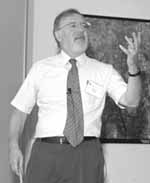 |
|
Asking for Trouble by Judy Jackson
These days it takes guts to be a graduate student in experimental particle physics. Your thesis research takes years, while detectors and accelerators are a-building. Funding for your chosen field grows ever more perilous, while you watch budgets for other branches of science go up. When you finally finish your degree, traditional university research jobs are scarcer than tau neutrinos. And the path to the future is anything but clear, as your elders attempt to converge on a vision for the years ahead. It's not a career choice for the faint hearted.
Yet last month, when the hardy band of Fermilab graduate studentsó the few, the strong, the chosenómet for their annual post-users'-meeting New Perspectives conference, they put enough of their own high energy into presenting and discussing their research to convince most observers that there's plenty of life left in high-energy physics.
The traditional opening-night poster contest attracted a crowded field of entries, and a large audience of poster cognoscenti. Detector components, charmonium results, Higgs searches, neutrino experiments, accelerator physicsóall those and more turned up, carefully diagrammed and thoroughly explained, at what must be one of the world's more specialized cocktail parties. Vadim Kashikin, a Russian graduate student in Fermilab's Technical Division, won first prize for his poster illustrating a breakthrough in the design of high-field superconducting magnets, a longtime Fermilab specialty.
For the following two days, the students presented papers describing their work on every aspect of Fermilab's experimental program. Amitava Roy from Purdue described work on tests of pixel sensors for the CMS experiment that Fermilab is helping to build for physics at the Large Hadron Collider at CERN. Jocelyn Monroe, who hasn't even begun grad school yet, talked about ionization cooling for a neutrino factory of the future. Bruce Knuteson of UC Berkeley explained his novel, model-independent search strategy to look for new physics at DZero. Stephen Bailey described a particle decay search using CDF data. And the University of Minnesota's Reinhard Schwienhorst presented a new upper limit for the magnetic moment of, yes, the tau neutrino.
"It's great," said Purdue graduate student Arnold Pompos, a CDF collaborator who chaired a session of the conference. "It's a chance to talk to your fellow students about the work you are doing without too much pressure. You can talk about whatever stage you're in."
Tigner described one piece of developing accelerator technology as "asking for trouble."
"But if you don't ask for trouble, you don't get it," he said.
Pause.
"And our whole careers are built on trouble."
His audience looked as if they could hardly wait. |
| last modified 8/4/2000 email Fermilab |
FRLsDFx9eyfrPXgV
 On Wednesday morning, renowned accelerator physicist Maury Tigner, the conference's keynote speaker, gave the students a rousing address on the intellectual adventure and romanceó and the practical necessityóof solving problems of accelerator physics in order for the field of particle physics to advance.
On Wednesday morning, renowned accelerator physicist Maury Tigner, the conference's keynote speaker, gave the students a rousing address on the intellectual adventure and romanceó and the practical necessityóof solving problems of accelerator physics in order for the field of particle physics to advance.